NCERT Notes For Class 6 Maths Chapter 8 Decimals Introduction
Savita and Shama were going to the market to buy some stationary items. Savita said, “I have 5 rupees and 75 paise”. Shama said, “I have 7 rupees and 50 paise”.
They knew how to write rupees and paise using decimals.
So Savita said, I have ₹ 5.75 and Shama said, “I have ₹ 7.50”.
Have they written correctly?
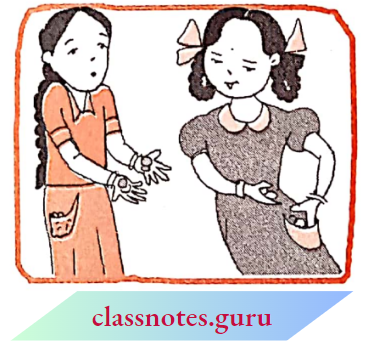
We know that the dot represents a decimal point.
In this chapter, we will learn more about working with decimals.
Comparing Decimals
Can you tell which is greater, 0.07 or 0.1?
Take two pieces of square paper of the same size. Divide them into 100 equal parts.
For 0.07 we have to shade 7 parts out of 100.
Read and Learn More NCERT Notes for Class 6 Maths
Now, 0.1 = \(\frac{1}{10}\) = \(\frac{10}{100}\), so, for 0.1, shade 10 parts out 100.
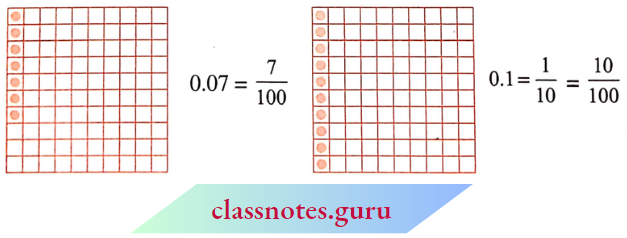
This means 0.1 >0.07
Let us now compare the numbers 32.55 and 32.5. In this case, we first compare the whole part. We see that the whole part for both the numbers is 32 and, hence, equal.
We, however, know that the two numbers are not equal. So, we now compare the tenth part. We find that for 32.55 and 32.5, the tenth part is also equal, and then we compare the hundredth part.
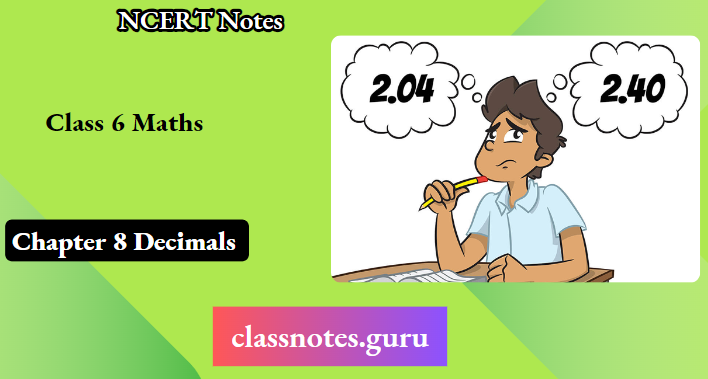
We find, 32.55 = 32 + \(\frac{5}{10}\) + \(\frac{5}{100}\) and 32.5 = 32 + \(\frac{5}{100}\) + \(\frac{0}{100}\), therefore, 32.55>32.5 as the hundredth part of 32.55 is more.
Example 1. Which is greater?
- 1 or 0.99
- 1.09 or 1.093
Solution:
(1) 1 = 1 + \(\frac{0}{10}\) + \(\frac{0}{100}\); 0.99 = 0 + \(\frac{9}{10}\) + \(\frac{9}{100}\)
The whole part of 1 is greater than that of 0.99.
Therefore, 1 > 0.99
(2) 1.09 = 1 + \(\frac{0}{10}\) + \(\frac{9}{100}\) + \(\frac{0}{1000}\); 1.093 = 1 + \(\frac{0}{10}\) + \(\frac{9}{100}\) + \(\frac{3}{1000}\)
In this case, the two numbers have the same parts up to a hundredth.
But the thousandth part of 1.093 is greater than that of 1.09.
Therefore, 1.093 > 1.09.
NCERT Notes For Class 6 Maths Using Decimals
Money
We know that 100 paise = ₹ 1
Therefore, 1 paise = ₹ \(\frac{1}{100}\) = ₹ 0.01
So, 65 paise = ₹ \(\frac{65}{100}\) = ₹ 0.65
and 5 paise = ₹ \(\frac{5}{100}\) = ₹ 0.05
What is 105 paise? It is ₹ 1 and 5 paise = ₹ 1.05
Length
Mahesh wanted to measure the length of his tabletop in metres. He had a 50 cm scale. He found that the length of the tabletop was 156 cm. What will be its length in metres?
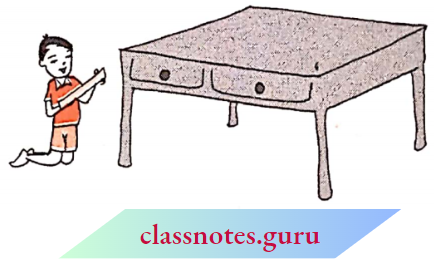
Mahesh knew that 1 cm = \(\frac{1}{100}\) m or 0.01 m
Therefore, 56 cm = \(\frac{56}{100}\) m = 0.56 m
Thus, the length of the tabletop is 156 cm = 100 cm + 56 cm
= 1 m + \(\frac{56}{100}\) m = 1.56 m
Mahesh also wants to represent this length pictorially. He took squared papers of equal size and divided them into 100 equal parts. He considered each small square as one cm.
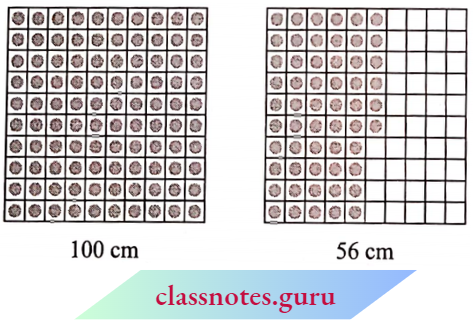
Weight
Nandu bought 500g potatoes, 250g capsicum, 700g onions, 500g tomatoes, 100g ginger and 300g radish. What is the total weight of the vegetables in the bag? Let us add the weight of all the vegetables in the bag.
500 g + 250 g + 700 g + 500 g + 100 g + 300 g = 2350 g
We know that 1000 g = 1 kg
Therefore, 1 g = \(\frac{1}{1000}\) = 0.001 kg
Thus, 2350 g = 2000 g +350 g
= \(\frac{2000}{1000}\) kg + \(\frac{350}{1000}\) kg
= 2 kg+ 0.350 kg = 2.350 kg

i. e. 2350 g = 2 kg 350 g = 2.350 kg
Thus, the weight of vegetables in Nandu’s bag is 2.350 kg.
NCERT Notes For Class 6 Maths Addition Of Numbers With Decimals
Add 0.35 and 0.42
Take a square and divide it into 100 equal parts
Mark 0.35 in this square by shading
3 tenths and colouring 5 hundredths.
Mark 0.42 in this square by shading
4 tenths and colouring 2 hundredths.
Now count the total number of tenths in the square and the total number of hundredths in the square.
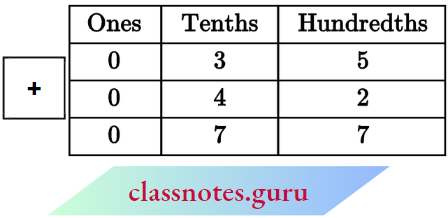
Therefore, 0.35 + 0.42 = 0.77
Thus, we can add decimals in the same way as whole numbers.
Can you now add 0.68 and 0.54?

Thus, 0.68 + 0.54= 1.22
Example 1. Lata spent 19.50 for buying a pen and ₹ 2.50 for one pencil. How much money did she spend?
Solution: Money spent for pen = ₹ 9.50
Money spent for pencil = ₹ 2.50
Total money spent = ₹ 9.50 +₹2.50
Total money spent = ₹ 12.00
Example 2. Samson travelled 5 km 52 m by bus, 2 km 265 m by car and the rest 1km 30 m he walked. How much distance did he travel in all?
Solution: Distance travelled by bus = 5 km 52 m = 5.052 km
Distance travelled by car = 2 km 265 m = 2.265 km
Distance travelled on foot = 1 km 30 m = 1.030 km
Therefore, the total distance travelled is \(\begin{array}{r}
5.052 \mathrm{~km} \\
2.265 \mathrm{~km} \\
+\quad 1.030 \mathrm{~km} \\
\hline 8.347 \mathrm{~km} \\
\hline
\end{array}\)
Therefore, total distance travelled = 8.347 km
Example 3. Rahul bought 4 kg 90 g of apples, 2 kg 60 g of grapes and 5 kg 300 g of mangoes. Find the total weight of all the fruits he bought.
Solution: Weight of apples = 4 kg 90 g = 4.090 kg
Weight of grapes = 2 kg 60 g = 2.060 kg
Weight of mangoes = 5 kg 300 g = 5.300 kg
Therefore, the total weight of the fruits bought is \(\begin{array}{r}
4.090 \mathrm{~kg} \\
2.060 \mathrm{~kg} \\
+\quad 5.300 \mathrm{~kg} \\
\hline 11.450 \mathrm{~kg} \\
\hline
\end{array}\)
The total weight of the fruits bought = 11.450 kg.
NCERT Notes For Class 6 Maths Subtraction Of Decimals
Subtract 1.32 from 2.58
This can be shown in the table.
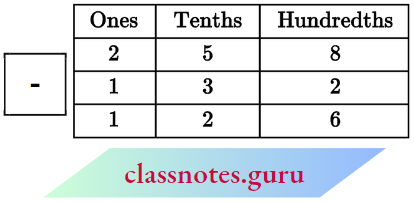
Thus, 2.58-1.32 = 1.26
Therefore, we can say that, subtraction of decimals can be done by subtracting hundredths from hundredths, tenths from tenths, ones from ones and so on, just as we did in addition.
Sometimes while subtracting decimals, we may need to regroup like we did in addition.
Let us subtract 1.74 from 3.5.
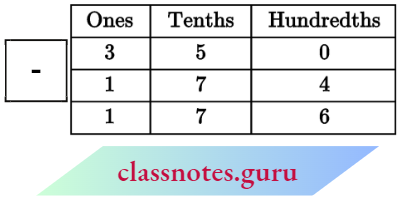
Subtract in the hundredth place.
Can’t subtract! so regroup \(\begin{array}{r}
{ }^2 3 .{ }^{14} 5{ }^{10} 0 \\
-1.74 \\
\hline 1.76 \\
\hline
\end{array}\)
Example 1. Abhishek had ₹ 7.45. Did he buy toffees for ₹ 5.30? hind the balance amount left with Abhishek.
Solution: Total amount of money = ₹ 7.45
Amount spent on toffees = ₹ 5.30
Balance amount of money = ₹ 7.45 – ₹ 5.30 = ₹ 2.15
Example 2. Urmila’s school is at a distance of 5 km 350 m from her house. She travels 1 km 70 m on foot and the rest by bus. How much distance does she travel by bus?
Solution: Total distance of the school from the house = 5.350 km
Distance travelled on foot = 1.070 km
Therefore, distance travelled by bus = 5.350 – 1.070 km
Thus, distance travelled by bus = 4.280 km or 4 km 280 m
Example 3. Kanchan bought a watermelon weighing 5 kg 200 g. Out of this, she gave 2 kg 750 g to her neighbour. What is the weight of the watermelon left with Kanchan?
Solution: Total weight of the watermelon = 5.200 kg
Watermelon given to the neighbour = 2.750 kg
Therefore, weight of the remaining watermelon = 5.200 kg-2.750kg =2.450kg
